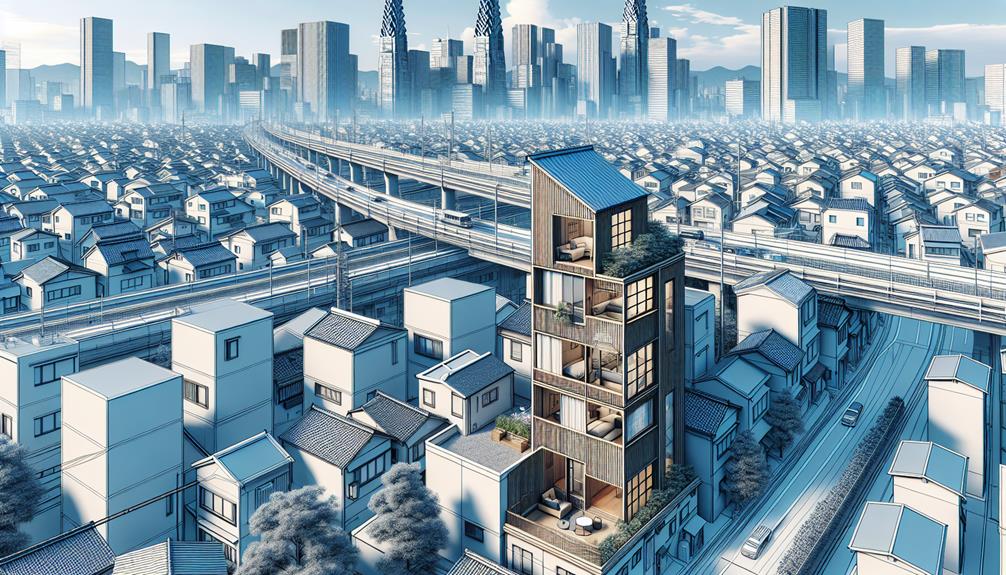In the midst of Japan's housing crisis, where population levels are soaring and urban density is increasing, extreme housing solutions have emerged as a means of tackling the pressing issue of affordability.
One such solution is the development of tiny coffin houses, aptly named for their minuscule size and lack of windows. These micro apartments, measuring just over 8 feet long and 4-5 feet tall, have become an unsettling yet necessary option for those seeking an affordable place to call home in Tokyo.
But what drives individuals to choose these confined spaces? And what are the challenges and criticisms associated with such extreme housing solutions?
As we explore the world of tiny coffin houses, we are compelled to question the boundaries of comfort, the effects of urbanization, and the future of housing in Japan's capital city.
Key Takeaways
- Coffin houses in Japan are extremely small micro apartments, measuring just over 8 feet long and 4-5 feet tall.
- These apartments are rented for as much as $600 US dollars a month and do not have windows, with all residents sharing a bathroom.
- Geki-sema or share houses have been developed in Tokyo as a response to the lack of affordable housing, providing tiny cabinets for sleep and storage.
- Living in such small spaces is a matter of debate, with some believing it is only suitable for those who would otherwise be homeless, while others have lower limits in terms of space requirements.
Coffin Houses: Japan's Micro Apartments
Coffin houses, also known as micro apartments, have emerged as a housing solution in Japan due to rising population levels and increased urban density. These tiny living spaces, measuring just over 8 feet long and 4-5 feet tall, offer a compact and efficient design to maximize the limited space available.
Design considerations for these micro apartments include clever organization, utilizing multi-purpose furniture, and optimizing storage solutions. However, while these micro apartments provide a solution to the housing shortage in Japan, affordability concerns remain. With rental prices reaching as high as $600 USD per month, some argue that the cost is too steep for such limited living space.
Balancing design innovation with affordability is a challenge that needs to be addressed in order to provide sustainable and accessible housing options for the growing population in Japan.
Geki-sema: Tokyo's Share House Solution
Tokyo's share house solution, known as geki-sema, is a housing concept developed by landlords to address the pressing demand for affordable housing in the capital city of Japan. This innovative approach has had a significant impact on the affordability of share houses, providing a solution for individuals who are in need of a place to sleep and store their belongings.
Here are four key aspects of geki-sema:
- Cost-effectiveness: Geki-sema offers a more affordable alternative to traditional housing options, allowing individuals to rent these tiny cabinets at a lower price point compared to larger apartments in Tokyo.
- Utilization of space: Despite their small size, geki-sema share houses are cleverly designed to maximize space efficiency. The limited area is optimized for sleep and storage, ensuring that residents can make the most out of their living arrangements.
- Meeting demand: With Tokyo facing a high demand for affordable housing, geki-sema provides a practical solution by offering compact living spaces that fulfill the basic needs of individuals without compromising on comfort.
- Flexibility: Geki-sema share houses cater to a diverse range of residents, including students, young professionals, and individuals who require temporary accommodation. This flexibility makes geki-sema an attractive option for those seeking affordable housing solutions in Tokyo.
Living in Small Spaces: Opinions and Considerations

Living in small spaces poses unique challenges and considerations for individuals seeking affordable housing solutions. While some may see it as a last resort for those who would otherwise be homeless, others may find potential advantages in this alternative option. Clever organization and efficient use of space can maximize the functionality of a small living area.
Additionally, individuals who have another place to spend their weekends may be more willing to consider living in a small space. However, there are also significant challenges to living in small spaces. Lack of space for basic bodily comfort, such as standing and stretching, can be a concern for long-term housing. Sharing kitchens and bathrooms may not be an issue for some, but having access to fresh air and natural light is important for overall well-being.
Ultimately, the decision to live in a small space requires careful consideration of personal preferences and needs.
Challenges of Tiny Living Spaces
One of the primary challenges associated with tiny living spaces is the limited physical space available for basic bodily comfort and movement. This can lead to feelings of claustrophobia and a lack of freedom to move around comfortably.
In addition, the small size of these living spaces presents cleanliness challenges. With limited space, it can be difficult to maintain cleanliness and organization, as there may not be enough room for storage or proper cleaning equipment.
Furthermore, the lack of windows in some tiny living spaces can make it challenging to have access to natural light and fresh air, which are important for maintaining a healthy living environment.
Criticisms of the Real Estate Market and Affordability

The limited physical space and challenges associated with tiny living spaces highlight the need for a critical examination of the real estate market and affordability. While the demand for affordable housing continues to rise, the real estate market, particularly in major cities like Tokyo, has been criticized for its inequality and predatory capitalist practices. Property ownership and the prioritization of monetary gains over human needs have played a significant role in the current housing crisis.
The exorbitant rent of $600 per month for these coffin houses is seen by some as a rip-off, further exacerbating the issue of affordability. The housing market's failure to provide adequate and affordable options highlights the urgent need for systemic change to address real estate market inequality and ensure access to affordable housing for all individuals.
Frequently Asked Questions
What Is the Average Size of a Coffin House in Japan?
The average size of a coffin house in Japan is just over 8 feet long and 4-5 feet tall. These micro apartments are developed in response to the high demand for affordable housing in densely populated areas.
Are There Any Alternative Housing Options Available for Those Who Cannot Afford Coffin Houses in Japan?
Alternative housing options for those who cannot afford coffin houses in Japan include innovative capsule hotels and shared housing communities. These options provide affordable and compact living spaces that cater to individuals with limited budgets and offer a sense of community.
How Do People Cope With the Lack of Space and Basic Comforts in Small Living Spaces?
People cope with the lack of space and basic comforts in small living spaces through innovative designs and storage solutions. They maximize space by utilizing creative techniques, such as multifunctional furniture and vertical storage systems, to create a more comfortable and organized living environment.
What Are Some Potential Health Risks Associated With Living in Tiny Coffin Houses?
Potential health risks associated with living in tiny coffin houses include physical discomfort from lack of space, limited ability to move and stretch, lack of natural light and fresh air, and psychological effects such as claustrophobia and feelings of isolation.
How Do the Rental Prices of Coffin Houses in Japan Compare to Other Affordable Housing Options in the Country?
The rental prices of coffin houses in Japan are relatively high compared to other affordable housing options in the country. Despite their small size and lack of amenities, these micro apartments can cost up to $600 per month, making them less affordable for some individuals.
Conclusion
In conclusion, Japan's housing crisis has given rise to extreme housing solutions such as tiny coffin houses and geki-sema. These micro apartments, although criticized for their small size and lack of amenities, have become a necessity for those seeking affordable housing in Tokyo.
Symbolically, these housing solutions represent the challenges faced by a growing population in a densely populated urban environment. Despite their limitations, they serve as a reminder of the need for innovative approaches to address the pressing issue of housing affordability in Japan.

